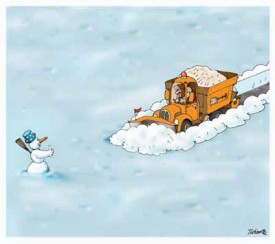Kosovo - okay, really, what next?
With 2009 having ended much as it began, the international community must continue to pursue a peacekeeping approach to the north in order to keep alive the possibility of a negotiated outcome.
(Gerrard Gallucci, TransConflict) Friday, January 22, 2010
Over the last few months, I have tried to present various facets of the difficult question of what to do about north Kosovo within the context of an overall status settlement. I have emphasized the continuing need to take a peacekeeping approach to the north - e.g., not seeking to settle political issues through force - to keep the door open for a negotiated outcome. Such an outcome might include a differential approach to implementing the Ahtisaari Plan, i.e., vigorous implementation of decentralization (plus allowed links to Belgrade) for Serb-majority municipalities south of the Ibar and an "Ahtisaari Plus" framework for the north (as an alternative to outright partition).
However, on the ground, 2009 ended much as it began. Having assumed the status-neutral mantle of the UN in November 2008, EULEX failed to act to implement the UN Secretary General's proposed six-point plan for addressing practical issues - such as courts, customs and transportation links - by implementing practical, non-political measures. EULEX decided it was better not to offend the Albanian majority by reaching accommodations with local Serb institutions and communities that appeared to accept the status quo of continued deep divisions over Kosovo independence. Indeed, EULEX stood back from, and in some cases assisted, Albanian efforts to bully the Serbs into accepting the Kosovo institutions that they dominate. EULEX allowed electricity blockages of southern Serbs and facilitated a forced, unilateral return of Albanians to a sensitive area (Brdjani) of north Mitrovica. Results were mixed. Under pressure, enough southern Serbs voted in the 2009 municipal elections to give them minimal credibility. But in the north, turning off the electricity simply led to "electricity partition" with Serbia stepping in to fill the gap and now even to start collecting fees.
Instead of seeking to work out status-neutral practical arrangements on customs and the courts, EULEX placed officers at the northern customs gates and in the Mitrovica court with the intention of introducing there Kosovo law, staff and links to Pristina. Urged on by the Albanians, EULEX and KFOR threatened use of force to implement such plans. However, EULEX in December formulated a strategy for winning space in the north for rule from Pristina (http://outsidewalls.blogspot.com/2010/01/kosovo-eu-strategy-for-north.html) that appears more political. It assumes that the northern Serbs have grown tired of resistance to Kosovo independence and will come to accept Pristina as they are freed from the baleful influence of "radical" local leaders. The EU also appears to be relying on President Tadić, eager for the political benefits of entering the EU, to help by removing the "radicals" and acquiescing to the gradual transition of the north to EULEX and then to Pristina. Both seem questionable assumptions. Serb resistance to Kosovo independence is deep and near universal and unlikely to disappear soon. The southern Serbs may be more accommodating as they have no alternative. But the northern Serbs have the alternative of remaining part of Serbia - as they functionally are - and Tadić is in no position to be seen giving them up. But at least the EU looks to be trying.
So, despite all the huffing and puffing from Pristina about "illegal" and "parallel" institutions and a commitment to "dissolve" them, in 2009 Kosovo remained divided at the Ibar. What about 2010? The watershed event may be the ICJ decision on the legality of independence. This could offer Pristina some benefit as anything less than an outright rejection of the declaration as illegal - unlikely - will help free up a second wave of recognitions; countries sympathetic but reluctant to recognize as long as a decision against independence remains possible will be able to move forward. However, a significant number will continue to refuse for their own reasons, probably including at least some of the EU holdouts. Thus the final status issue and the question of the north are unlikely to be settled by the ICJ decision alone. This will only get done by an eventual new round of negotiation. It could be that Pristina and friends seek a final solution in the north through the use of force. But as this would risk provoking a wider crisis, we can expect the EU to hold back as long as the northern Serbs themselves do not outright surrender. So, the status quo may continue in the north. This is not all bad as it also allow for the possibility of a negotiated outcome.
Negotiations will not come easy. Both sides will have to give up something. Carefully calibrated compromise could leave the north nominally in Kosovo but substantially in Serbia. But this may be beyond the parties and the mediators. Partition would be the less elegant solution. But it would have the virtue of requiring both sides to give up something they value: Serbia would of course lose Kosovo but the Albanians would have to accept loss of the north.
2010 may be the year that Kosovo status, and that of the north, really gets settled. Or maybe it will just be more of the same divided status quo. Either would be better than renewed conflict but negotiations would be best and everyone may come to see this after some further theatre.
Gerard M. Gallucci is a retired US diplomat. He served as UN Regional Representative in Mitrovica, Kosovo from July 2005 until October 2008. The views expressed in this piece are his own and do not represent the position of any organization.
You can read more of Mr. Gallucci's analysis of current developments in Kosovo by visiting http://outsidewalls.blogspot.com/
http://www.transconflict.com/News/2010/January/Kosovo_Okay_Really_Whats_Next.php






